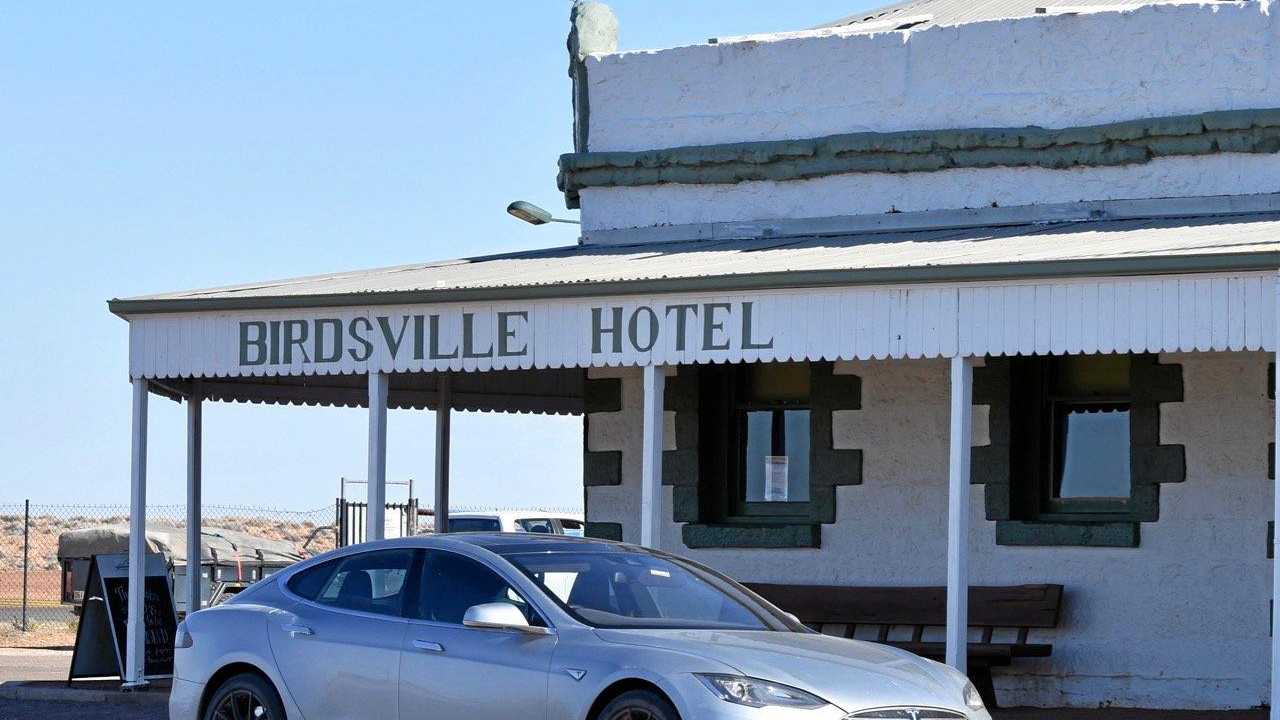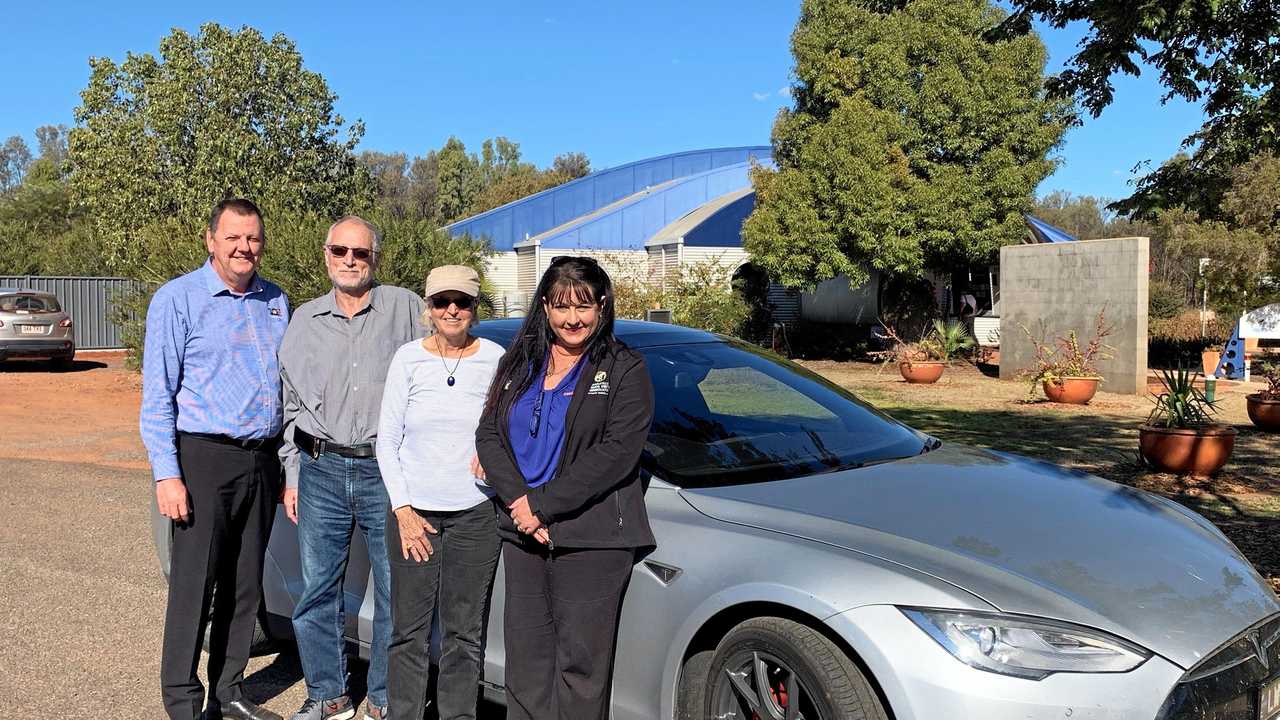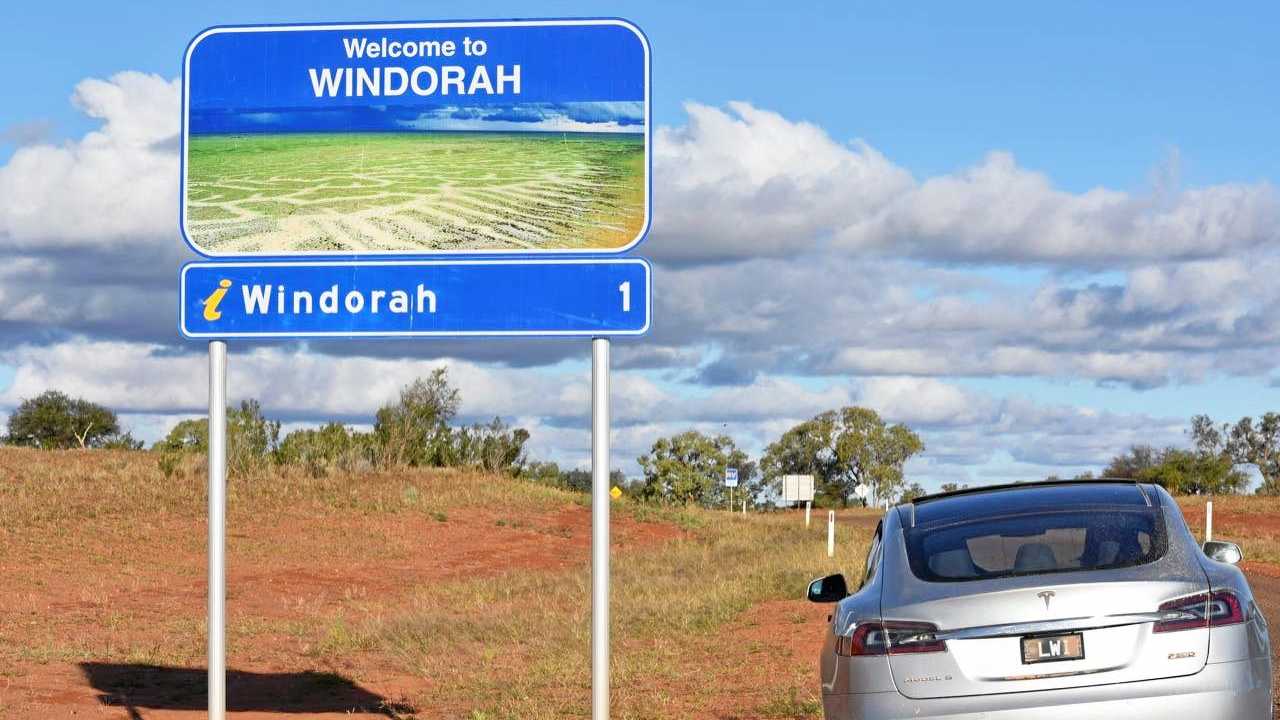Tesla drivers conquer the Queensland outback
A couple from Melbourne has made the 4300 round trip to Birdsville and back, with stops throughout the southwest.

Roma
Don't miss out on the headlines from Roma. Followed categories will be added to My News.
KEITH and Lesley Wein are on no ordinary road trip.
In their electric car, they embarked on the 2150km journey from Melbourne to Birdsvile without a hitch, and now they're heading back the way they came.
Their journey in a Tesla Model S is a potential first for south-west Queensland towns such as Charleville, Quilpie and Windorah, where outback locals rarely see electric powered vehicles passing through.
Despite the scarcity of charging points, an outback journey in an electric car is not impossible.
"There is nothing to stop you travelling in an electric vehicle, but I'm pretty sure that I am the first one to get this far," Mr Wein said.
"The route I took was to get, first of all, to Bourke where there are known charging points, and from there we went to Cunnamulla, Charleville, Quilpie, to Windorah and then to Birdsville."

The first leg of the 2150km trip was done in six days, including charging stops and overnight stops. They decided not to drive between dusk and dawn to avoid any wildlife and ultimately, it worked out to take one day longer than in a regular petrol car.
It is far from the longest drive the engineer and his partner have done in their Tesla, which just ticked over 70,000km on the odometer.
"I actually bought one of the first Teslas in to Australia, I have replaced it once for a better model, and have been doing nothing but driving it since then. I don't have any other vehicle," Mr Wein said.
"We only really use it for very long trips like this, because we live in Melbourne and the public transport is good for getting around at home, so the 70,000-odd kilometres we have done have been all over Australia."
The Weins are no strangers to cross-country road trips in their Tesla, with previous trips to Perth, Cairns and throughout their home state of Victoria.
But it's their trek through the outback that will be one of the most memorable, going where no electric vehicle drivers have gone before.
"The last leg on the Birdsville Development Rd was a challenge, as the car set-up for the road conditions required more than normal battery energy, and a cross wind evident on the last half of the trip also added to the energy requirements," Mr Wein said.
"When arriving at Birdsville I had travelled a total of 388km from the last charge at Windorah, and had 42km remaining in the battery. It was a bit touch and go on that stretch."
An engineer and long-time electric car enthusiast, Mr Wein has been excited to see what his Tesla is capable of.
If it weren't for careful planning, their story could have been very different.
Being pioneers of electric vehicle tourism has meant a lot of organisation to find power sources for the Tesla, in order to charge efficiently.

"Obviously if there is no infrastructure where you are going, as there isn't going to Birdsville, it becomes a little difficult with the arrangements you must make for charging, but it is still possible," Mr Wein said.
"In all those cases I simply phoned the information officers and some councils have also been really helpful, and have allowed us to use their three-phase power at places like the showgrounds.
"They have been really, really helpful - I can't stress enough how good people have been to help us."
The couple have garnered more than just a helping hand on their unique trip. Their Tesla has also been sparking interest from almost everyone they meet.
It has become a chance to not only show off the impressive car and its technology, but prove the possibilities to others.
"As soon as we got to Birdsville, we were stopped by an interested man who had read about Teslas and seen them before, but never thought he would see one out here," Mr Wein said.
"The reactions have been very positive, and most people who have helped us along the way have said they expect there is going to be more of these things, and I think they are right, because the number of electric vehicles on the road is growing."
In the past four years, four million electric vehicles had been sold worldwide, and the Electric Vehicle Council of Australia expects we will catch up with the growing markets in China and America.
Currently there are 23 models of electric cars available in Australia, and much of the uptake has been driven by businesses, but the EVC wants to see change.
"Business continues to be the largest buyer of electric vehicles accounting for 63 per cent of sales," EVC CEO Behyad Jafari said.
"Private buyers also make up a substantial portion of the market accounting for 34 per cent of sales," Mr Jafari said.
"The growth in the Australian electric vehicle market demonstrates the need for urgent policy support by government.
Having made it to a new frontier for electric cars, Mr Wein is hopeful the vehicles' popularity will spread to more rural areas.
"Everyone has wanted to understand more about what they can do, and small towns especially love the idea of putting chargers because as people have found out on the east coast, where there are lots of chargers, if an electric car stops to charge for two hours, the question is: 'what do you do for two hours?'.
"The answer is of course, you go to shops and have coffee or something to eat, and make the most of the break, and that's not bad for any locality."

Beginning the return journey late last week, the Weins planned to take the second leg of their trip a little slower, in order to enjoy what outback Queensland has to offer.
"The return journey on the Bridsville Development Rd has been successfully completed, and now we are on sealed roads heading home, the challenge is to drive safely," Mr Wein said.
"We thank all those who had made this possible when charging the car on the return journey; these small Queensland inland towns are extremely friendly and hospitable, and have given tremendous support."
Originally published as Tesla drivers conquer the Queensland outback






